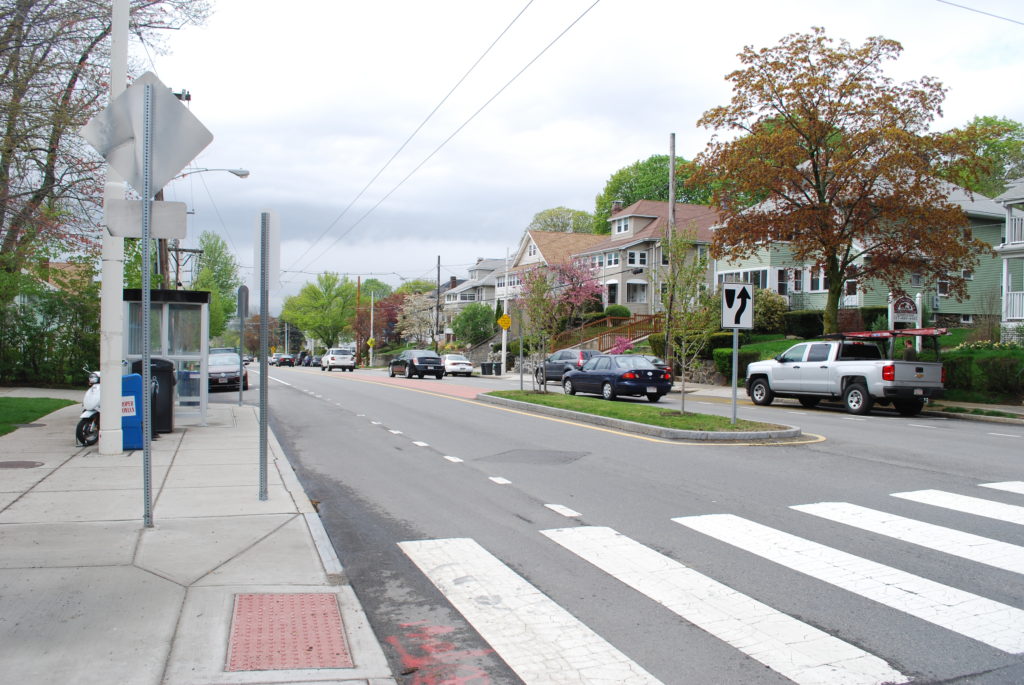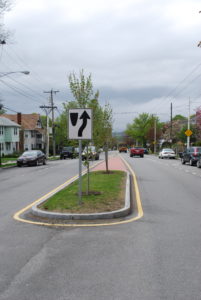Belmont’s “Main Street” Gets A Facelift
by Sue Bass
How does a municipal project get done, in Belmont or anywhere? What’s the spark?
The redesigned and newly paved Belmont Street/Trapelo Road stretch through Belmont—from the Waltham line to the Cambridge line—recently won an award from the American Council of Engineering Companies of Massachusetts for the BSC Group, the town’s longtime engineering consultant. “Incorporating bicycle lanes, pedestrian accessibility, and traffic calming measures, the $17.1 million roadway reconstruction project was one of the first designed in conformance with the MassDOT Highway Design Guidebook,” the citation reads. “Distinguishing project features include coordination with the MBTA trackless trolley, incorporation of 350 street trees, and interconnection of 13 signalized intersections.”

Trapelo Road, looking west from the corner of Williston Road in Cushing Square. Improvements include the center divide, clear bike lane markings, enlarged crosswalk, newly paved and expanded sidewalk, and covered waiting area at the bus stop (at left.). John DiCocco photos.
That new roadway and some of the new buildings along it were inspired in part by work that the Belmont Citizens Forum did more than 15 years ago. Conscious that the organization was seen as implacably antidevelopment (since we were litigating to prevent construction on open space at McLean Hospital), we decided to consider what development we’d favor, and where.
The $17.1 million roadway reconstruction project was one of the first designed in conformance with the MassDOT Highway Design Guidebook.
The Belmont Street/Trapelo Road corridor—wide, shabby, and dangerous to cross—sprang quickly to mind. Though it crosses two of the town’s three major business districts, it had received little attention. A new Planning/Zoning Committee of the Citizens Forum gathered in the spring of 2002. We started brainstorming and research. Teams of members photographed every building along the two-and-a-half-mile artery and assembled the photos on the walls of Katharine and Michael MacPhail’s former architectural studio in Cushing Square (about where Vicki Lee’s is now.)
The committee recruited two groups of students to study the corridor. The Community Design Studio of the Boston Architectural Center started work in January 2003 and exhibited its recommendations in June of that year at the MacPhails’ studio. A graduate school class from MIT’s Department of Urban Studies and Planning worked in the fall of 2004 and presented its report at Town Hall in December 2004.
The BCF Planning/Zoning Committee created its own program to highlight the decades of neglect of this major artery, which we called Belmont’s Main Street. The committee’s video, Creating a Vision, was first shown in April 2003. It aimed to redefine the corridor from a commuter thoroughfare into a neighborhood street that would serve residents and shopping districts.
During the discussion at the Belmont Studio Cinema that followed that video, Alan McClennen, Arlington’s town planner, emphasized that the prime customers for those local businesses live within half a mile of the shops.
$30,000 Planning Grant
The town was also active. In September 2002, Belmont received a $30,000 planning grant from the Metropolitan Area Planning Council, and the Belmont’s Vision 21 Committee began forming the group popularly called BEDPG, pronounced “bed-peg,” the Business and Economic Development Planning Group, which filed its final report in March 2005. The town’s Traffic Advisory Committee focused on the corridor, mandating a narrowing of Trapelo Road—a “neckdown” in traffic jargon—at Hawthorne Street, where many students crossed to reach the Butler School. Similar neckdowns became part of the final design. Finally, after many glitches, the roadwork is done.
Changes in the buildings that line the road are taking longer. Belmont’s Planning Board was working in the mid-aughts to rethink the zoning. After a chemical spill was reported in 2004 at the site of Tops Cleaners on Common Street, the Planning Board began in 2006 to consider an overlay rezoning district for Cushing Square. Hundreds of hours of meetings led to the Cushing Village development that is finally getting underway after delays for financing. Other appealing businesses have opened in that square. The area around the Studio Cinema is also perking up, and plans are in the works to spruce up Waverley Square.
Is the work so far perfect? Bicyclists would say not. The state-mandated bike lanes are narrow, and they’re not protected from motor vehicle traffic, as cyclists would wish. The road and sidewalk reconstruction seemed to take inordinately long; residents had to put up with noisy diesel buses instead of silent trolleys for several years. How comfortable Belmont will be with the three-and-a-half-story Cushing Village development is still a question.
But if you take a look at the corridor in 2003—the Creating a Vision video is available in the library—you’ll see plenty of changes for the better.
Sue Bass is director emerita of the Belmont Citizens Forum Newsletter.


Sorry, the comment form is closed at this time.